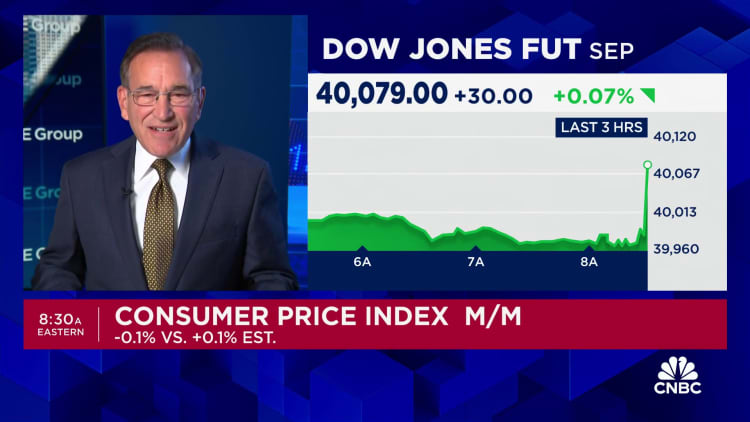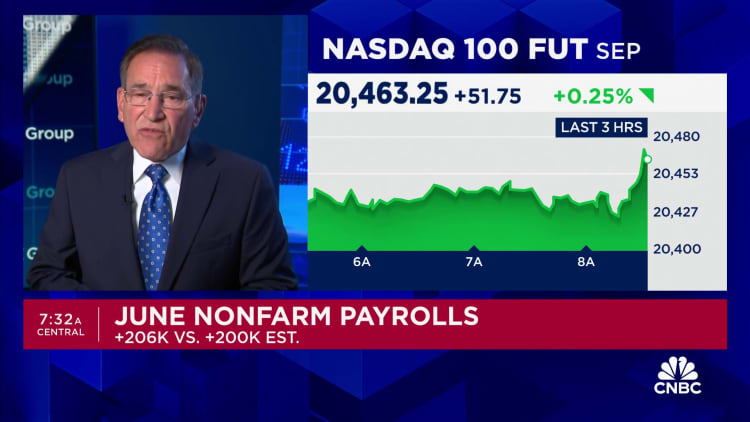David Paul Morris/Bloomberg via Getty Images
Inflation fell further in June as lower gasoline prices combined with other price pressures eased consumers’ wallets.
The consumer price index, a key gauge of inflation, rose 3% in June from a year earlier, down from 3.3% in May, the U.S. Labor Department reported Thursday.
The CPI measures how quickly prices change across the U.S. economy. It takes into account everything from fruits and vegetables to haircuts, concert tickets and appliances.
Perhaps the most “encouraging” news for consumers is that inflation for essential goods has slowed significantly, said Mark Zandi, chief economist at Moody’s Analytics.
“The prices of basic necessities – food at home, gasoline, rents on new leases – have not changed in about a year,” Zandi said. “So people are paying the same price for these necessities today as they were a year ago.”
The April inflation rate is down sharply from the peak of 9.1% reached during the pandemic in 2022, which was the highest level since 1981.
However, it remains above the long-term target of policy makers, around 2%.
“We continue to expect inflation to ease in the months ahead as input cost pressures ease and tepid consumer demand makes it harder (for businesses) to raise prices,” Sarah House and Aubrey George, economists at Wells Fargo Economics, wrote in a note this week.
However, further improvements will likely be “slow,” they wrote.
Good sign for Fed rate cut in September
The U.S. Federal Reserve uses inflation data to guide its interest rate policy. It has raised interest rates to their highest level in 23 years during the pandemic, pushing up borrowing costs for consumers and businesses in an effort to control inflation.
Last month, Fed officials projected they would begin cutting rates by the end of 2024.
“All indications are that inflation has moderated, is back close to the Fed’s target and consistent with a rate cut in September,” Zandi said.
Gasoline prices weigh on inflation

There has also been a general drop in prices in grocery stores.
Prices for “food at home” have increased by only 1.1% since June 2023, according to CPI data.
Consumers have more “room to maneuver” in stores because of “increasing promotional activity” among retailers, while a few “large” companies have recently announced price cuts “that are likely to put pressure on competitors’ prices,” economists House and George wrote.
Core CPI at three-year low
While annual data on inflation trends is useful, economists generally recommend looking at monthly figures to better understand short-term movements and prevailing trends.
They also generally like to look at “core” inflation numbers. They exclude food and energy prices, which can be volatile from month to month.
The monthly core consumer price index (CPI) stood at 0.1% June’s increase was the weakest in about three years, since August 2021. It has fallen for three straight months, compared with 0.4% in March. (Back on target, economists say the monthly reading should consistently be in the range of about 0.2%.)
The “core” CPI rose 3.3% since June 2023, the smallest 12-month increase since April 2021.
Shelter is the largest component of the core CPI and therefore has a significant impact on inflation figures. It accounted for almost 70% of the total 12-month increase in the core CPI.
House price inflation has fallen much more slowly than expected, which is a key reason why inflation has not yet fallen back to target, economists said.
The housing index lags behind general rental market trends because of the way the government constructs it.
Economists expect the housing sector to continue to slow, however, as market rent inflation has fallen. For example, the annual inflation rate for new rental contracts fell to 0.4% in the first quarter of 2024, below its pre-pandemic baseline, after peaking at about 12% just two years earlier, according to data from the Bureau of Labor Statistics.
The latest CPI report provided encouraging signals: monthly house price inflation fell to 0.2%, after stagnating at 0.4% for four consecutive months. This is the smallest monthly increase since August 2021.
“The situation should continue to calm down,” said Joe Seydl, senior market economist at JP Morgan Private Bank.
“It just takes time,” he added.
Services inflation is the sore point
Physical goods inflation soared as the U.S. economy reopened in 2021. The Covid-19 pandemic disrupted supply chains, while Americans spent more on their homes and less on services such as dining out and entertainment.
It is a different story today. Goods inflation has largely normalized, while services inflation has remained uncertain.
“The goods situation looks very favorable at the moment,” said Olivia Cross, North America economist at Capital Economics. “There is still work to be done in some areas, like basic services and housing.”
For example, prices for services such as auto insurance and medical care have increased “notably” by 19.5% and 3.3% since June 2023, respectively, the BLS said.
Prices for basic necessities — food at home, gasoline, rents on new leases — have not changed in about a year.
Marc Zandi
Chief Economist at Moody’s Analytics
Rising prices for new and used cars a few years ago are likely fueling high inflation for car insurance and repairs today, because it generally costs more to insure and repair more expensive cars, economists said.
It also takes a long time — a year, two or even three — for higher health care labor costs to translate into CPI numbers because of a lengthy contracting process, Zandi said. Higher pandemic-era wages in health care are now pushing up the medical care CPI, and that will likely happen in the coming year, he said.

The services sector is generally more sensitive to inflationary pressures in the labor market, such as strong wage growth.
Record demand for workers as the economy reopened after the pandemic propelled wage growth to its highest level in decades. The labor market has since cooled and wage growth has declined, though it remains above its pre-pandemic level.
“The inflationary pressure on the labor market has dissipated quite significantly,” Cross said.